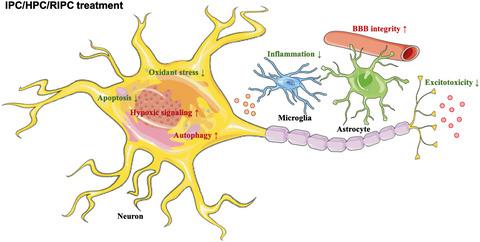当前位置:
X-MOL 学术
›
CNS Neurosci. Ther.
›
论文详情
Our official English website, www.x-mol.net, welcomes your
feedback! (Note: you will need to create a separate account there.)
Neuroprotective effects and mechanisms of ischemic/hypoxic preconditioning on neurological diseases
CNS Neuroscience & Therapeutics ( IF 4.8 ) Pub Date : 2021-07-08 , DOI: 10.1111/cns.13642 Jia Liu 1 , Yakun Gu 1 , Mengyuan Guo 1 , Xunming Ji 1, 2
CNS Neuroscience & Therapeutics ( IF 4.8 ) Pub Date : 2021-07-08 , DOI: 10.1111/cns.13642 Jia Liu 1 , Yakun Gu 1 , Mengyuan Guo 1 , Xunming Ji 1, 2
Affiliation

|
As the organ with the highest demand for oxygen, the brain has a poor tolerance to ischemia and hypoxia. Despite severe ischemia/hypoxia induces the occurrence and development of various central nervous system (CNS) diseases, sublethal insult may induce strong protection against subsequent fatal injuries by improving tolerance. Searching for potential measures to improve brain ischemic/hypoxic is of great significance for treatment of ischemia/hypoxia related CNS diseases. Ischemic/hypoxic preconditioning (I/HPC) refers to the approach to give the body a short period of mild ischemic/hypoxic stimulus which can significantly improve the body's tolerance to subsequent more severe ischemia/hypoxia event. It has been extensively studied and been considered as an effective therapeutic strategy in CNS diseases. Its protective mechanisms involved multiple processes, such as activation of hypoxia signaling pathways, anti-inflammation, antioxidant stress, and autophagy induction, etc. As a strategy to induce endogenous neuroprotection, I/HPC has attracted extensive attention and become one of the research frontiers and hotspots in the field of neurotherapy. In this review, we discuss the basic and clinical research progress of I/HPC on CNS diseases, and summarize its mechanisms. Furthermore, we highlight the limitations and challenges of their translation from basic research to clinical application.
中文翻译:

缺血/缺氧预处理对神经系统疾病的神经保护作用及机制
大脑作为对氧气需求量最高的器官,对缺血缺氧的耐受性较差。尽管严重的缺血/缺氧会诱导各种中枢神经系统(CNS)疾病的发生和发展,但亚致死损伤可能会通过提高耐受性来诱导对随后的致命伤害的强烈保护。寻找改善脑缺血/缺氧的潜在措施对于治疗缺血/缺氧相关的中枢神经系统疾病具有重要意义。缺血/缺氧预处理(I/HPC)是指给予机体短时间的轻度缺血/缺氧刺激,可显着提高机体对后续更严重的缺血/缺氧事件的耐受性。它已被广泛研究并被认为是中枢神经系统疾病的有效治疗策略。其保护机制涉及多个过程,如激活缺氧信号通路、抗炎、抗氧化应激、诱导自噬等。作为诱导内源性神经保护的策略,I/HPC受到广泛关注,成为研究前沿之一。和神经治疗领域的热点。本文就I/HPC治疗中枢神经系统疾病的基础和临床研究进展进行综述,并总结其作用机制。此外,我们强调了它们从基础研究转化为临床应用的局限性和挑战。I/HPC引起了广泛关注,成为神经治疗领域的研究前沿和热点之一。本文就I/HPC治疗中枢神经系统疾病的基础和临床研究进展进行综述,并总结其作用机制。此外,我们强调了它们从基础研究转化为临床应用的局限性和挑战。I/HPC引起了广泛关注,成为神经治疗领域的研究前沿和热点之一。本文就I/HPC治疗中枢神经系统疾病的基础和临床研究进展进行综述,并总结其作用机制。此外,我们强调了它们从基础研究转化为临床应用的局限性和挑战。
更新日期:2021-07-09
中文翻译:

缺血/缺氧预处理对神经系统疾病的神经保护作用及机制
大脑作为对氧气需求量最高的器官,对缺血缺氧的耐受性较差。尽管严重的缺血/缺氧会诱导各种中枢神经系统(CNS)疾病的发生和发展,但亚致死损伤可能会通过提高耐受性来诱导对随后的致命伤害的强烈保护。寻找改善脑缺血/缺氧的潜在措施对于治疗缺血/缺氧相关的中枢神经系统疾病具有重要意义。缺血/缺氧预处理(I/HPC)是指给予机体短时间的轻度缺血/缺氧刺激,可显着提高机体对后续更严重的缺血/缺氧事件的耐受性。它已被广泛研究并被认为是中枢神经系统疾病的有效治疗策略。其保护机制涉及多个过程,如激活缺氧信号通路、抗炎、抗氧化应激、诱导自噬等。作为诱导内源性神经保护的策略,I/HPC受到广泛关注,成为研究前沿之一。和神经治疗领域的热点。本文就I/HPC治疗中枢神经系统疾病的基础和临床研究进展进行综述,并总结其作用机制。此外,我们强调了它们从基础研究转化为临床应用的局限性和挑战。I/HPC引起了广泛关注,成为神经治疗领域的研究前沿和热点之一。本文就I/HPC治疗中枢神经系统疾病的基础和临床研究进展进行综述,并总结其作用机制。此外,我们强调了它们从基础研究转化为临床应用的局限性和挑战。I/HPC引起了广泛关注,成为神经治疗领域的研究前沿和热点之一。本文就I/HPC治疗中枢神经系统疾病的基础和临床研究进展进行综述,并总结其作用机制。此外,我们强调了它们从基础研究转化为临床应用的局限性和挑战。











































 京公网安备 11010802027423号
京公网安备 11010802027423号